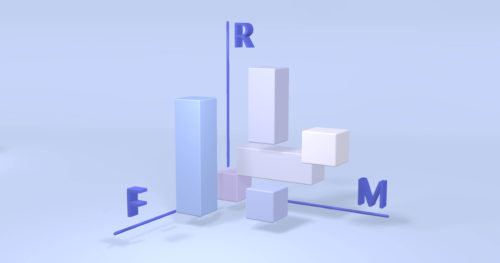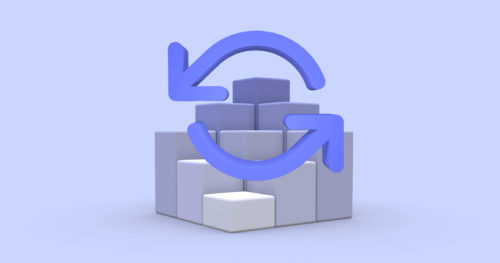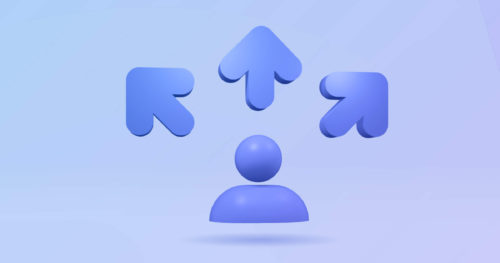Targeting the right niche is not easy, especially if you are only familiar with traditional methods, i.e., demographical or geographical segmentation. But there is more to your customers than just their age and location. Aspects such as interests, income, occasion, needs, brand loyalty, etc., also play a crucial role in purchasing decisions.
So how do you understand your customers, their needs, and intents and do so in a way that positively impacts your marketing efforts?
Let’s take a look!
What Is Behavioral Segmentation?
Behavioral segmentation involves grouping or clustering customers based on common behavioral patterns. Typically, these behaviors (and subsequent purchase patterns!) are related to behavioral parameters, such as customers’ activity on the website, interaction with the brand, reaction to marketing messages, purchase frequency, satisfaction levels, etc.
This segmentation can be done effectively with tools such as artificial intelligence-based analysis platforms. Since predictive modeling helps businesses predict future behavior from customers, they can create marketing messages that find their target niche and make it more effective.
Why Is It Important?
Behavioral segmentation in marketing is vital for businesses because it helps them find the right audience that will respond to their product’s marketing messages.
Aside from benefiting from personalization, it helps businesses with budget allocation. By understanding how much to spend and how to maximize ROI, businesses can curb wasteful spending.
Other advantages include:
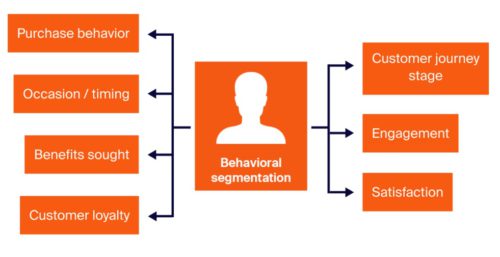
1. Identifying High-Value Customers
For businesses, it is critical to identify their high-value customers as this segment increases their revenue through purchases. They also influence others to perceive the brand positively.
Through behavioral segmentation, businesses can identify which customers are valuable and could become loyal customers or unofficial brand ambassadors. It allows business owners to track how customers spend, what they spend the most on, where they buy their products, and when they make these purchases.
In this way, a business could build a marketing plan that will allow more customer interaction, such as features and content, to build more responsiveness in their target market.
With key insights into high-value customer behavior, businesses can increase their existing customers’ lifetime value (CLV), improve customer retention, and increase the CLV of these high-value target customers.
2. Identify Services and Products That Are Worthy of Investment
Companies can use behavior segmentation in marketing to identify popular products or services for their consumers. They can also use the data collected to identify which products need improvement. Key insights such as these will also help businesses determine which products require more resources and how to expand their customer reach. They can also examine whether underperforming products need improvement or if they’re better off being dropped.
3. Remove Blocks on the Customer Journey
Customers often face challenges such as long waiting periods, complex purchase systems, lack of support, expectation mismatch, etc. Behavior segmentation in marketing can help businesses identify pain points in the customer journey and improve the situation. For instance, if online shoppers often abandon their carts or don’t complete their transactions, businesses can segment such customers, interact with them to learn more about their experiences, and then take appropriate steps.
4. Improves User Experience Design
Behavioral segmentation also allows businesses to improve the user experience through better user experience (UX) design.
When existing customers use websites, mobile apps, and other digital platforms, they often encounter issues that prevent them from completing their customer journey. Through this kind of segmentation, businesses can identify where and when their consumers lost interest or what propelled them to continue through the customer journey.
They can then design a digital site that creates a better experience for their target users and identify user status through their interaction with the design.
How Does It Work?
Behavioral segmentation in marketing groups customers by their behavior. It also uses other information such as demographics and geographical data to predict their future behavior related to a service or product.
Businesses can then use the insights gained from behavioral segmentation to adjust their marketing strategy.
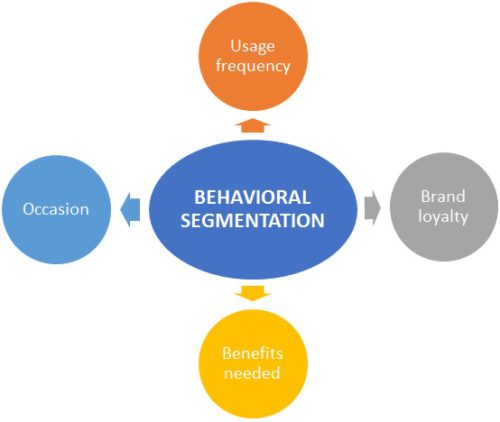
Example
While behavioral segmentation takes many forms, a prime example is observing occasion-based behavior (by the way, we’ve created an exclusive article full of behavioral segmentation examples and strategies here). This happens when an occasion triggers a consumer to make a purchase. For instance, people buy certain products or services during the holidays or personal milestones, such as anniversaries or birthdays.
This specific product or service sales spike affects a large part of the target market and can be observed across all demographics.
When consumers make purchases to mark an annual celebration such as a wedding or a birthday, it can be called a regular personal occasion since it happens yearly. Equally, some behavioral segmentation examples occur rarely and mark milestones that do not happen regularly. Examples include milestones such as retirement or receiving special honor from an institution.
This type of segmentation allows a business to create a marketing scheme based on these segments, thereby targeting specific consumers within these segments.
Types of Behavioral Segmentation in Marketing
Behavioral segmentation can be divided into five types or forms based on consumers’ behavior during their customer journey. Here’s a closer look at these types or forms and why they’re important.
Purchasing Behavior
Businesses can segment consumers based on their purchasing behavior. This includes transaction history, purchasing decisions, and the specific behaviors that are likely predictors of a possible purchase. Businesses can create marketing strategies when analyzing purchasing behavior as the scientific data obtained from this can give them actionable insights.
Purchasing behavior can be divided further into four categories.
1. Complex
A complex purchasing behavior requires the customer to make an important decision and puts them as highly involved in the purchasing process. Customers often do a lot of research and compare the benefits and differences of similar products before deciding. For instance, when a customer wants to buy a car, they will conduct extensive research into manufacturers, compare different models, consider the cost of shortlisted models, fuel efficiency, maintenance ease, etc., before deciding.
2. Variety Seeking
Variety-seeking behavior includes brands or products that have significant differences or variations. The consumer is not highly involved in the decision-making and purchasing process as the decision is not significant in their lives. This means that whatever product or brand they choose, it still has the same effect regardless of the purchase. OTC products (over-the-counter) like ointments, cough syrups, bandaids, pain relievers, etc., do not involve complex purchase decisions.
3. Dissonance-Reducing
Dissonance-reducing purchasing behavior requires a customer to decide between two very similar products. If the products have few differences or benefits, the customer will likely decide based on whether or not they will benefit from the purchase. The price of the product or service is typically what sways a customer’s decision.
4. Habitual
Habitual behaviors depend on a customer’s brand loyalty, personal choice, and personal experience. Consumers choose certain brands because, after repeat purchases from that brand, they’re comfortable with that brand and choose to continue their association with the brand.
Occasion Purchasing
Occasion purchasing segmentation occurs when consumers make purchase decisions based on specific times or circumstances in their personal lives.
Here’s a look at the three kinds of occasion purchasing in behavioral segmentation.
1. Life Stage
Life Stage is when customers make purchase decisions when they reach specific milestones in their lives. These could include getting married, buying a house, or even starting a family.
2. Seasonal
Seasonal purchasing decisions are based on seasonal factors such as holidays, weather, similar changes, even the start of a school year.
3. Day-Part
Day-part is habitual purchasing decisions based on the time of day when the consumer buys a product. Consider hot beverages such as coffee or tea. They’re typically purchased in the morning. Similarly, sandwiches and meals are more likely to be bought at lunch or dinner.
For some businesses, day-part purchasing is vital because it can leverage customer behavior and increase revenue.
Customer Journey Stage
This strategy focuses on the brand’s customer journey. It helps businesses increase conversion rates by identifying which marketing strategy will work and what will increase a customer’s satisfaction levels.
Customers can engage and interact with the brand at any point in the customer journey, at any channel, and with any content. This is perhaps what makes this segmentation difficult for marketers to analyze. Thankfully, artificial intelligence (AI) and digital technology simplify the process by collecting customer data and comparing all the data points along the customer journey stage.
Usage Behavior Segmentation
This behavior segmentation is based on the number of times consumers use or purchase products or services. Purchase and usage behavior segments customers based on the products they use, the length of time they use the product, and what kind of features interest consumers. Customer loyalty segmentation can indicate which ones could increase customer lifetime value (CLV).
User rate segmentation has three categories, as described below.
- Heavy/Super Users – Consumers that use a product or service frequently and are most engaged with the brand’s content and features.
- Medium/Averge Users – Consumers that use the product or service but not frequently enough to classify as heavy users.
- Light Users – Consumers that use the products only once or less than average consumers.
Customer Loyalty
This segmentation strategy focuses on the most loyal customers who generate the most revenue for the business. This segmentation type helps businesses answer questions about what behaviors would indicate customer loyalty and customer satisfaction, and which ones have the highest CLV and merit membership in a customer loyalty program.
How to Use This Kind of Segmentation in Your Marketing Strategy
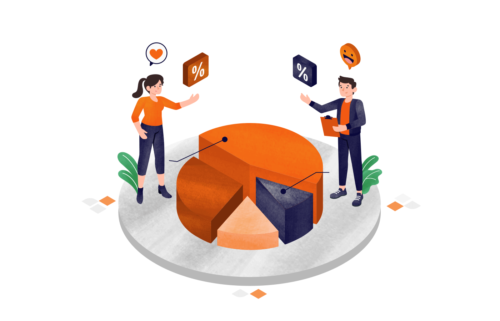
Behavioral segmentation is an efficient way to reach your target audience and create marketing messages and marketing materials that will likely compel your target audience to make a purchase. However, research shows that almost 76% of companies do not use it.
Consider the following tips if you’ve been wondering how best to leverage this kind of segmentation to boost your marketing efforts.
1. Research Your Audience
Businesses could use surveys, audience analysis, track behavioral data, and conduct interviews to know their target audience’s interests and preferences. These methods could help them identify the trends that lead to a purchase.
2. Create Buyer Personas
Companies should then create a buyer persona or a complete customer profile that includes detailed descriptions of a customer’s demographic information, goals, pain points, and even preferences. An audience analysis could help business owners fill in the information they need, so the marketing is targeted for the right audience.
3. Map Out the Buyer Journey
Once you have your buyer personas, you need to plan the buyer journey that shows how customers engage with your brand and what activity or engagement interests them at each part of the marketing funnel (Awareness, the Engagement, Evaluation, Purchase, and Post-purchase phase.) Businesses can also map out pain points and possible questions that the consumer could raise during the whole journey.
With this insight, you can create a content map that will plan out how each content is linked to the customer journey and how your brand’s content could nurture customers throughout the journey. This will eventually improve your customers’ satisfaction levels.
4. Develop a Marketing Campaign Using Behavioral Segmentation
Once a company has created buyer personas, mapped out the customer journey, and created a content map that nurtures customers, marketers can identify the themes that inspire customer activities and behavior.
Marketers could then use different types of behavioral segmentation to present possible marketing opportunities.
How to Improve Segmentation by Behavior for eCommerce
While behavior segmentation offers several advantages (better focus, stronger brand identity, accurately targeted marketing, etc.), several challenges deter businesses from investing. These include cost, prediction accuracy rates, dependency on assumptions, etc.
Digital technology can make behavioral segmentation more effective by tracking customer choices and purchasing behavior better.
Here’s a closer look at how.
1. Use Purchase Behavior
Study which actions and activities helped or influenced your customers to decide by collecting and collating data from online engagements and interactions. For instance, a post-workout bottled water or health drink purchase. Similarly, events such as weddings will trigger jewelry or fancy clothes purchases.
Companies can then customize their marketing strategies to suit the specific purchase behavior that would target those consumers and encourage more leads to convert and become sales.
2. Cluster Customers in the Same Customer Journey Stage
Why not cluster your audience in the same stage of the customer journey? If you focus on segmenting customers who belong in the same stage of the journey, then you could use the same engagement for this cluster and increase the chance of a conversion.
To increase the effectiveness of this strategy, companies need to be able to determine every customer’s current journey accurately. It does require the use of algorithms. You’ll also need to study patterns of behavior for a long period.
The benefits are worth it, though, as the sales cycle is shortened and the number of loyal customers and turnover rates increase significantly.
3. Use Purchase Frequency
Are your customers first-time buyers or repeat customers? Knowing the purchase frequency of your products or services could inform a marketing team if their efforts are working and which strategies fit your target audience.
You could then identify which customers are super users and which ones are single-time or first-time users. You’ll also get better insight into which actions or activities create new customers and nurture your current ones to become super users.
An eCommerce site makes it easier for companies to trace the average customer’s location and transaction history. They can then use their buyer persona to check the likelihood of the customer becoming a super user.
4. Focus on Customers Availing Specific Benefits
Products or services are designed to help solve problems that customers face. Unfortunately, not many businesses are adept at highlighting how their products or services address these problems. When businesses market their products’ specific benefits, their customers will likely stay with the product or service and become loyal customers.
5. Customers Seeking Variety
When consumers seek variety, they often focus on options that allow them to browse and compare products or services before deciding.
If your target audience fits within this category of variety-seekers, you should create a marketing strategy based on their personality, preferences, and even economic limitations. When products or services don’t offer variety and personalization, then customers decide based on their personality and background. Plan a marketing strategy that focuses on the preferences of the majority of your target base, and your conversion rates will increase.
6. Occasion-Based Behavior
eCommerce sites will prosper when they use occasion-based behavior segmentation. Map out personal occasions or seasonal events that compel your customer base to make a purchase decision. These could include summer holidays, birthdays, graduation days, weddings and anniversaries, etc.
This marketing segmentation will influence your strategy, and by focusing on these special times and tailoring your marketing message accordingly, you will see more engagements and leads from your target audience.
User Segmentation and Machine Learning
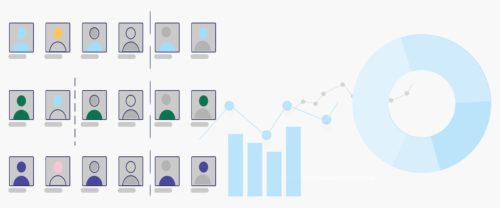
Behavioral segmentation can help companies allocate resources to maintain a level cost per acquisition (CPA) and increase revenues. Machine learning makes this all the more possible when the appropriate segmentation is used.
Companies can plan the right marketing campaigns for the target audience and reduce marketing waste when the right number of resources targeted to the right audience produce the most number of conversions.
Machine learning (digital technologies such as artificial intelligence (AI) algorithms and other computerized analyses) can process customer data using predictive modeling and machine learning models. These models can then help marketers identify customer trends across different variables or factors, such as geographic and demographic data.
The K-means Algorithm
Many kinds of machine learning are used for business and marketing, but the K-means clustering algorithm is used to segment customers. This is also called unsupervised algorithms since it lacks labeled data to evaluate performance. The main concept is to group data into similar clusters.
How to Use Machine Learning Algorithms for Customer Segmentation
While the choice of tools and partners depends on preference, companies can follow the following steps to create customer segmentation with machine learning.
1. Plan a Business Case
Begin by building a case research covering consumer habits and styles across different demographics, infographics, and even geographics. Check for customer engagements and how customers interact with sellers. See whether these customer interactions result in conversions that are worthy of attention. Businesses also need to review the number of products or services purchased, return rates, and the company’s spending on the campaign.
2. Collect and Arrange the Relevant Data
You need to collect data from different sources, such as demographics, infographics, and geographics, and assemble it to reveal certain patterns, trends, and biases in the data set. Businesses need to choose the relevant metrics such as the median lifetime value, the total revenue, maintenance spending, total consumer purchase cost, and consumer engagement rating.
Businesses might need to find missing values when using open source tools or software such as Python, especially since some data sets are vital for visualization. The more customer data you have, the better your forecasting and marketing analysis will be when you segment your customers using machine learning.
3. Use K-Means Algorithm for Segmentation
K-means algorithm uses different data sets, grouping customers based on factors that are attainable and small enough for a business to identify.
Using k-means clustering sets a random value of k as the number of clusters. Then the algorithm allots a data point to the nearest cluster that is grouping customers while relocating the center of the main group.
The algorithm checks and reviews the clusters reducing distances and middle points for all clusters. When all the data points agree, the algorithm ends the process.
4. Tuning the Model Using the Hyperparameters
The marketers will then determine the best hyperparameters or the values that control the process or the creation of the clusters. These hyperparameters become the main measure in behavior patterns or customer segmentation in machine learning.
5. Visualization
Once the algorithm has completed the process and the top parameters for the behavior have been identified, the company and its marketers can then visualize the data using a plotting library to create graphs, plots, and charts. These help businesses understand customer behavior patterns and how their marketing affects certain segments.
It could enhance your audience targeting and marketing plans and create customer engagement activities in the customer journey that will produce the most conversions and increase brand loyalty.
It will also reveal which target customers are most likely to become loyal, which are more likely to return, and which behavior will turn single users into repeat consumers.
Conclusion
All customers have basic needs (food, clothes, homes, transport, etc.). They also seek varied benefits from a product or service—picking a tooth whitening toothpaste over a regular one, oil control facewash over regular soap, vitamin or mineral-enriched skincare products, organic produce over GMO, etc. Triggers such as events, holidays, etc., prompt people to make purchases.
When businesses invest in understanding what these motivators are, they can capitalize by tailoring their marketing efforts and messages. Whether it’s rewarding frequent purchases or personalizing products and services to attract new segments, behavioral segmentation creates relevance, removes ambiguity from marketing messages, increases retention of high-value customers, making company spending more effective.
FAQs
The four categories under purchasing behavior are Complex, Variety-Seeking, Dissonance-Reducing, and Habitual. Understanding these, categorizing your customers based on their purchase behavior, and leveraging insights to tailor your marketing efforts will help your business achieve its targets.
Behavioral segmentation divides the target market into specific groups based on customer attitude, purchase decision, product use, knowledge, response or engagement, and lifetime value.
The five types of behavioral segmentation are purchase behavior, occasion purchasing, customer journey stage, customer loyalty, and usage behavior segmentation. An in-depth understanding of these will help businesses create a complete consumer persona and actionable insights that, when implemented, will increase the efficiency of their marketing efforts.

